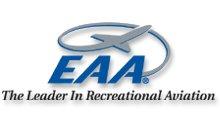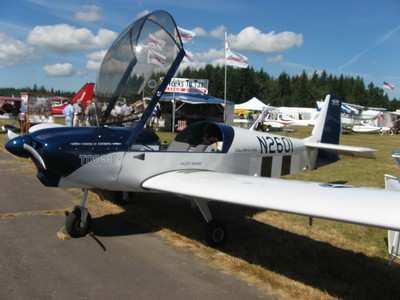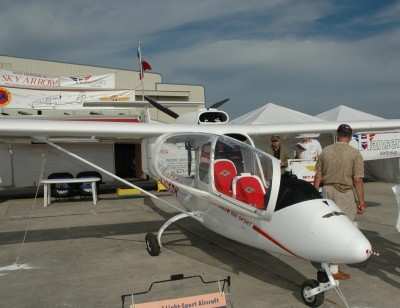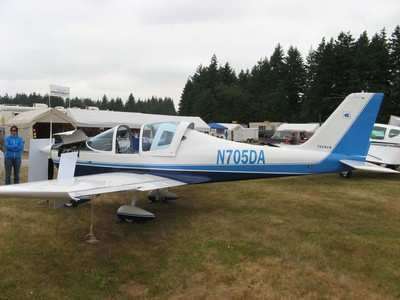Much Accomplished... But Issues Remain
 In just two years, the
sport pilot/light-sport aircraft community has grown to be a
significant and promising part of the general aviation picture. So
says representatives with the Experimental Aircraft Association...
who tell ANN that the past year, in particular, showed the
potential within this new area of recreational flight.
In just two years, the
sport pilot/light-sport aircraft community has grown to be a
significant and promising part of the general aviation picture. So
says representatives with the Experimental Aircraft Association...
who tell ANN that the past year, in particular, showed the
potential within this new area of recreational flight.
Over more than a decade of direct involvement and leadership on
the rule, the EAA sees the two-year anniversary of what's commonly
known as the "sport pilot rule" as a point of celebration and
renewed motivation to continue building access for those who wish
to participate.
"The past year was a remarkable one in terms of the sport
pilot/light-sport aircraft community's growth," said Earl Lawrence,
EAA's vice president of industry and regulatory affairs, who also
chairs the ASTM International committee that created the consensus
standards for light-sport aircraft.

EAA's annual review regarding sport pilot/light-sport aircraft
comes as interest in this new area of flying has met -- and
surpassed -- the anticipated levels.
"The number of new, ready-to-fly airplanes available to sport
pilots has blossomed in the past year," Lawrence said. "There are
more instructors, more training facilities and more opportunities
than expected after two years under the new rule. Although much
work remains to be done in a number of fronts, sport pilot offers a
way to increase current participation in aviation. Even more
importantly, it creates an entryway for those interested in outdoor
recreation to consider aviation as a safe, affordable, fun and
fulfilling pursuit."

On numerous occasions, FAA Administrator Marion Blakey has
specifically praised EAA for its work in developing the sport
pilot/light-sport aircraft community as a way to build interest in
recreational aviation. Administrator Blakey remains a staunch
supporter of this rule and its potential to create more flying
opportunities nationwide.

Among the milestones EAA cites in the second year of the sport
pilot/light-sport aircraft rule:
- More than three dozen new, affordable, ready-to-fly aircraft
are now available for purchase by sport pilots, for one-quarter to
one-half of the cost of traditional new, factory-built
airplanes;
- More than 400 new Sport Pilot certificates have been issued as
of August 1, 2006;
- More than 100 Sport Pilot instructors are now
certificated;
- More than 500 light-sport aircraft are on the FAA register (not
counting type-certificated and amateur-built aircraft that are also
eligible to be flown by sport pilots);
- More than 200 designated pilot examiners authorized to give
sport pilot flight tests (checkrides);
- More than 1,300 successful applicants in the sport pilot airman
knowledge (written) test.
- More than 2,100 EAA ultralight transition kits distributed in
two years;
- The Light Aircraft Manufacturing Association (LAMA) has created
an audit program that assures manufacturers and consumers that new
light-sport aircraft meet established ASTM International standards.

In addition, the involvement of long-established companies such
as Cessna in the light-sport aircraft field, announced at EAA
AirVenture Oshkosh 2006, marks a historic moment for this new
aviation sector. Light-sport aircraft companies in North America
have also made substantial progress in bringing airplanes to the
marketplace after trailing already-established European companies
when the rule became effective in 2004.
Issues Remain
Along with this substantial progress, a number of challenges
remain before a full, vibrant sport-pilot community can take shape.
Some primary issues include:
- Maintenance: There needs to be continued
efforts to develop maintenance courses and make them more widely
available.
- Medical certification: EAA's efforts and
recommendations to FAA have done much to help clear the special
issuance backlog, but some potential sport pilots still find
themselves in a "Catch-22" situation since they need to clear items
that may have caused a previous denial or revocation of a airman
medical certificate.
- Education: As with any new rule, there remains
some confusion regarding insurance, airport access and potential
transition deadlines. EAA's efforts in this area will continue and,
in some cases, be redoubled.
- Outreach: EAA Sport Pilot Tour reached
thousands of aviation enthusiasts in major metropolitan markets
during 2006, with as many as half of those attending currently not
involved in aviation. These outreach efforts are essential to
connect with potential sport pilots who are now outside of
aviation.

EAA, The Leader in Recreational Aviation, is an international
association with 170,000 members and 1,000 local Chapters.
 Classic Aero-TV: The Switchblade Flying Car FLIES!
Classic Aero-TV: The Switchblade Flying Car FLIES! ANN FAQ: Q&A 101
ANN FAQ: Q&A 101 ANN's Daily Aero-Term (04.12.24): Discrete Code
ANN's Daily Aero-Term (04.12.24): Discrete Code ANN's Daily Aero-Term (04.13.24): Beyond Visual Line Of Sight (BVLOS)
ANN's Daily Aero-Term (04.13.24): Beyond Visual Line Of Sight (BVLOS) ANN's Daily Aero-Linx (04.13.24)
ANN's Daily Aero-Linx (04.13.24)








